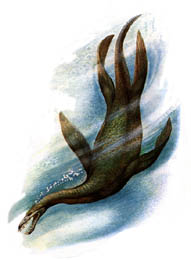Sauropterygia: Pliosauroidea
Taxa on This Page
- Archaeonectrus X
- Bishanopliosaurus X
- Eurycleidus X
- Pliosauroidea X
- Thalassiodracon X
Descriptions
 Pliosauroidea:
Pliosauroidea:
Range: Late Triassic (Early Jurassic?) to Late Cretaceous.
Characters: 3 to 12 m; Large head, skull and snout heavy and elongated; occipital condyle from basioccipital only; conical teeth with numerous vertical ridges, frequently showing wear at the tip; teeth may have keels; premaxillae with 5 tooth pairs; dentaries with 25-40 tooth pairs; neck short and thick, ~13 cervical vertebrae; 23-24 dorsal vertebrae; centra short; propodials long, with femur longer than humerus; hyperphalangy with up to 16 segments in longest digit; ischia long; adapted for streamlining and larger paddles, (seal-like pursuit hunter?).
Links: Walking with Dinosaurs - Chronology: 149 million years ago; Marine Reptiles (NOT Dinosaurs); Plesiosauria Translation and Pronunciation Guide; Pliosauroidea; saf4029-01.html; p3 - pliosaur2.jpg (?); 2_88_1.pdf; Kronosaurus German).
References: Brown (1981). MAK990812, ATW011117.
Bishanopliosaurus: B. youngi Dong 1980.
Range: Early Jurassic (Toarcian) of China (Sichuan).
Phylogeny: Pliosauroidea: Thalassiodracon + (Archaeonectrus + Eurycleidus + (Rhomaleosauridae + Pliosauridae)) + *.
Characters: ~4m; freshwater pliosaur.
Links: Plesiosauria Translation and Pronunciation Guide.
Note: may be a rhomaleosaurid. ATW020630.
 Thalassiodracon: T. hawkinsi Storrs & Taylor 1996 (previously Plesiosaurus hawkinsii Owen 1838. The change in spelling of the specific name is apparently due to an error by Seeley, now perpetuated).
Thalassiodracon: T. hawkinsi Storrs & Taylor 1996 (previously Plesiosaurus hawkinsii Owen 1838. The change in spelling of the specific name is apparently due to an error by Seeley, now perpetuated).
Range: Late Triassic (Rhaetian) to Early Jurassic (Hettangian) of Europe (England).
Phylogeny: Pliosauroidea: Bishanopliosaurus + (Archaeonectrus + Eurycleidus + (Rhomaleosauridae + Pliosauridae)) + *.
Small form rarely up to 2m; head small (10% total length, but proportionately larger than Plesiosaurus); skull of light construction; rostrum short & pointed (but proportionately longer than Plesiosaurus); upper temporal fenestra small, jugal elongate; cheek deeply excavated; mandibular symphysis spatulate; neck of moderate relative length (40% total length & 31-32 vertebrae); ~21-23 dorsals; 3-4- sacrals; 35 caudals; propodials & without massive distal expansion; humerus relatively straight; ischium elongate; anterior face of pubes rounded; hindlimbs slightly longer than forelimbs in adult (contra, Plesiosauria Translation and Pronunciation Guide).
Note: more typically classified as a basal plesiosauroid, Thalassiodracon may seem an unlikely candidate for a basal pliosaur. However, the shape of the pubes and lower jaw, as well as the larger size of the hindlimbs, are pliosauroid. In any case, we will follow Pliosauroidea after O'Keefe, 2001 until we have a chance to follow up on this issue.
Links: The Plesiosaur Site - Species; Plesiosaur References - STORRS & TAYLOR 1996; Plesiosauria Translation and Pronunciation Guide. MAK990901, ATW030519.
 Archaeonectrus: A. rostratus Novozhilov 1964 (= Plesiosaurus rostratus Owen 1865)
Archaeonectrus: A. rostratus Novozhilov 1964 (= Plesiosaurus rostratus Owen 1865)
Range: Early Jurassic (Sinemurian) of Europe (England) & possibly Russia.
Phylogeny: Pliosauroidea:: Eurycleidus + (Rhomaleosauridae + Pliosauridae) + *.
Characters: head large & elongated (compared to Plesiosaurus) (~15% total length); snout narrow; orbits round; teeth pointed, conical and recurved; neck relatively short (20-25% total length); cervical vertebrae (20) short; 27? dorsal vertebrae; 3? sacrals; 34 caudals; some caudal centra vertically compressed (Owen suspected a caudal "fin" of some kind); hindlimbs larger (= longer?) than forelimbs.
Note: remember that the image shows the pectoral girdle in dorsal view. Most of the other images here are ventral views.
Links: Plesiosauria Translation and Pronunciation Guide. MAK990903, ATW020630.
 Eurycleidus: E. arcuata Andrews 1922 (= Plesiosaurus arcuata Owen 1840)
Eurycleidus: E. arcuata Andrews 1922 (= Plesiosaurus arcuata Owen 1840)
Range: Early Jurassic of Europe, Psiloceras planorbe ammonite zone, (early Hettangian age) Bitton and Somerset, England.
Phylogeny: Pliosauroidea:: Archaeonectrus +
(Rhomaleosauridae + Pliosauridae)) + *.
Characters: ~4m overall; skull large & broad; Jugal short, not underlying orbit; postorbital and cheek bar dorso-ventrally deep; quadrates overlap the quadrate rami of the pterygoids anterolaterally; occiput said to be plesiosaur-like; exoccipitals- opisthotics participate in occipital condyle; prootics bridging the basioccipital- basisphenoid gap; fenestra ovalis small; parasphenoid with reduced participation in floor of braincase; coronoid absent; prearticular small; crowns of teeth curved, with weakly developed carinae and variably developed ridge ornament; symphysis covers at least four tooth positions; at least 5 pairs of large procumbent teeth anteriorly (on premaxilla); teeth not diminishing in size immediately behind the premaxilla-maxilla suture; at least 22 sets of very small teeth posteriorly; neck stout; neck vertebrae elongate (plesiosauroid character); cervicals with notch between the pre- and postzygapophyses; interclavicle broader than long; coracoids long (pliosauroid character); humerus larger than femur ?); radius & ulna much longer than tibia & fibula.
Note: [1] Eurycleidus was previously included in the family Leptocleididae. However, it also appears to be closely related to Rhomaleosaurus. The Rhomaleosauridae are often grouped together with the leptocleidine pliosaurs. Since Leptocleidus is the only certain member of the Leptocleididae, we treat the rhomaleosaurs as the only relevant supergeneric taxon, in order to avoid pointless discussion of a monogeneric family. We also follow Rhomaleosauridae after O'Keefe, 2001 in placing Eurycleidus outside the Rhomaleosauridae altogether. However, there is substantial contrary authority. Cruickshank & Long (1997) make the comparison between Eurycleidus and Leptocleidus several times. Storrs & Taylor (1996) have even considered Eurycleidus arcuata to be the same animal as Rhomaleosaurus megacephalus. [2] Cruickshank 1994) asserts that the skull of this animal combines plesiosauroid and pliosauroid features.
Image: from Praveký svet
Links: Plesiosauria Translation and Pronunciation Guide; The Plesiosaur Site; Praveký svet Slovak -- I think); a pair of Eurycleidus arcuatus (really good sketch).
References: Cruickshank 1994), Cruickshank & Long 1997), Storrs & Taylor (
1996). MAK991206, ATW030411.
Using this material. All material by ATW is public domain and may be freely used in any way (also any material jointly written by ATW and MAK). All material by MAK is licensed Creative Commons Attribution License Version 3.0, and may be freely used provided acknowedgement is given. All Wikipedia material is either Gnu Open Source or Creative Commons (see original Wikipedia page for details). Other graphics are copyright their respective owners


 Thalassiodracon
Thalassiodracon Archaeonectrus
Archaeonectrus